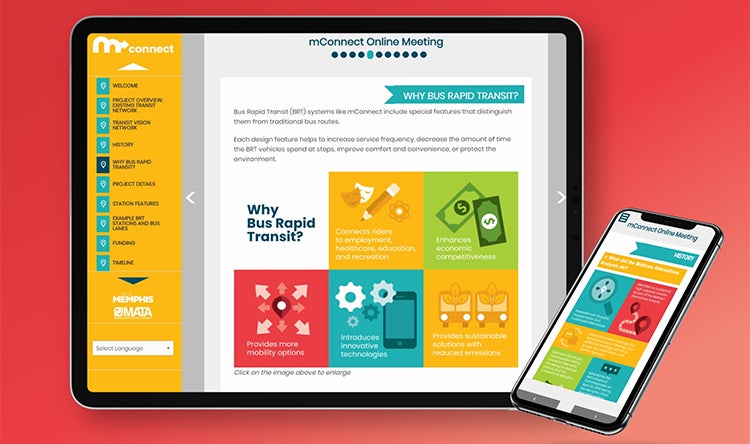
When the Open House Is Closed; A Playbook for Virtual Public Engagement
Part 1 in a series on Transitioning to a Culture of Virtual Engagement
Even in a Pandemic, Public Input on Infrastructure Projects Can Continue
Most public involvement practitioners could write a book about the sometimes unusual encounters of working in the public realm. We often swap stories about this; collective highlights include protest groups in superhero costumes and a gentleman singing a comment from his belly button at a formal hearing. At one public meeting, a miniature Shetland pony trotted around wearing protest signs. Yes, working with the public and stakeholders is occasionally colorful, and yet more often than not, critical to overall program or project success. These times are no different. Public engagement and continued project development do not need to come to a halt during a time of social distancing, in fact, communication must increase.
The Fundamental Purpose Hasn’t Changed
The public still needs — and is often required — to have a meaningful voice in infrastructure projects. Stakeholders still have key knowledge and information that can help inform solutions. We still have a duty to reach underserved populations.
The good news is that you don’t have to start from scratch. As an industry, we have spent the last decade advancing virtual engagement, and there are countless lessons learned and best practices to help guide you. There is also a wide variety of tools and platforms — some are brand new and others have been around for a while — to support your efforts.
Here are five steps for creating a virtual engagement program. We have also provided a few case studies to help you imagine the possibilities and see them in practice.
Step 1: Determine the Goal of Your Public Engagement Efforts
Start by defining what you want to achieve with your public engagement and determine how input will be used. Then define what information you need to collect to achieve this goal. This will help to inform the scale of your engagement, identify your target audiences, determine the timing of events and the type of engagement tools you need.
Here are a few questions to think about during this step:
- Do you need to collect input on identified alternatives?
- Is your goal to build informed consent or consensus around a decision?
- Is the generation of ideas important?
- What is your timeline for gathering input?
- Are you required to formally record the event?
- Will you need to address language barriers?
- Does your target audience have access to technology?
- How much education do you need to provide for the public to give informed, meaningful input?
Step 2: Determine Regulatory Requirements
Federal, state and local agencies are modifying existing guidance to include standard practices for virtual engagement. The most comprehensive guidance to-date has been issued from the Department of Interior and provides recommendations for public participation during COVID-19. As another example, the Federal Highway Administration approved a new provision in the Texas Department of Transportation Environmental Toolkit that defines the conditions in which a virtual meeting can supplement or replace in-person meetings.
The National Environmental Justice Council, a federal advisory council to the U.S. Environmental Protection Agency, published Model Guidelines for Public Participation, which includes online platforms and social media as options to consider for community engagement. Section 508 from the Department of Health and Human Services requires that all website content be accessible to people with disabilities. Similarly, the Department of Justice amended the Americans with Disabilities Act to address the accessibility of state and local government websites for people with disabilities.
Step 3: Take Inventory of the Tools You Already Have
Many organizations have most of the tools they need. For example, most mapping software can produce interactive story maps that are highly effective. Also, consider the social media platforms your organization may already be using to engage the public — almost all of these networks offer live streaming capability with chat features that might meet your needs. And don’t forget about your corporate website and audio/visual systems.
Be careful not to ignore some of the time-honored, more traditional methods of outreach that are still relevant. Email newsletters, voicemail systems and snail mail are still important tools to consider, as well as mass media outlets that continue to reach wide audiences. Neighborhood associations, community newspapers, radio advertisements and TV broadcasts are other tools to keep in mind. And don’t forget about leveraging the communication efforts of elected officials and other community partners.
Step 4: Explore New Options for Virtual Engagement

After taking inventory of what you already have, you may determine that what you’re missing can be solved with a subscription to an online service like text polling or electronic surveying. Maybe you need a specialized translation solution specifically designed for multi-lingual events. Perhaps a telephone town hall is a good option, in which case this guide from the National Council on Aging will be useful.
One of the most frequently used methods of virtual engagement is the on-demand online public meeting like this example from Metro Transit in Minneapolis. This type of website can effectively replace in-person open house meetings by featuring experts, project details and an opportunity to comment around the clock. There are many other useful off-the-shelf products as identified in this list published by the International Association for Public Participation.
Step 5: Assess Community Sensitivity
Our communities are juggling a lot of information right now. The key to implementing online engagement during this time of uncertainty is to understand the sensitivity of your communities. Lead with empathy as you craft your message around your decision to go online and how you anticipate input to be impacted due to COVID-19. Consider extended comment periods and advertise manual and virtual comment methods equally.
Organizers in Charleston County, South Carolina, recently decided to shift an important public open house to an all-virtual engagement effort. Staff and elected officials carefully weighed the pros and cons of delaying the in-person meeting in a time of crisis versus extending the project’s schedule. In the end, everyone agreed that holding an online meeting would still facilitate public involvement while keeping a critical infrastructure project on schedule. Read more about the Charleston County’s experience.
In the End, It’s Still About Connecting

While disruption can be uncomfortable, it’s also a chance for agencies and leaders to enhance relationships with their communities. Creative and flexible methods will enable residents to have access to important information about projects in their neighborhoods, and empathetic messaging will remind communities that we’re in this together. With the right tools and considerations, people will still be able to sing the national anthem with their belly buttons — perhaps just from their own homes for now.
Be on the lookout for future articles in this series that will address a number of topics like:
- Evolving agency guidance on virtual engagement
- Thoughtful engagement strategies for disadvantaged populations
- Designing for the experience of virtual engagement
- Testing your brand for virtual resilience
About the Authors
Theresa McClure is a vice president in our Charleston, South Carolina, office where she serves as the East region strategic communications manager. She is an innovator at heart and excels at finding clear ways to educate the public on complex topics that have the potential to change the way they live.
Stephanie White is a senior vice president and director of our strategic communications program. She is known for her energy and extraordinary creativity in building consensus between groups with competing interests. She lives in Denver.
Our full-service Strategic Communications program helps clients manage the social and political risk associated with infrastructure development. Our public involvement teams design communication campaigns customized to fit a community or owner’s needs and deploy the latest technologies to improve connection, enhance public awareness and build stakeholder support. We leverage web, video, social networking and other media strategies to support the successful planning, design and delivery of critical infrastructure programs.


